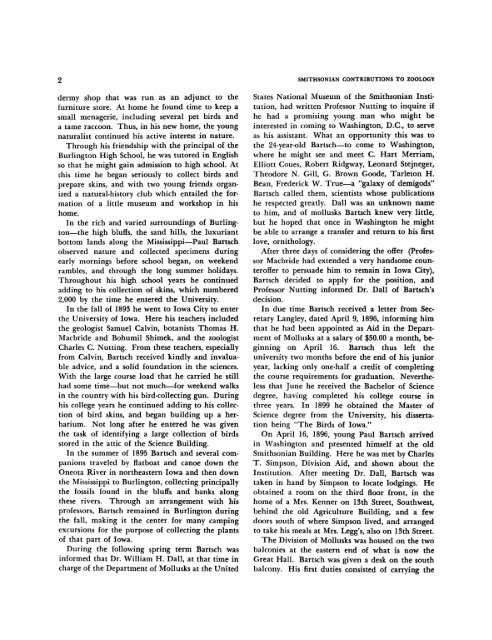Bibliography and Zoological Taxa of Paul Bartsch - Smithsonian ...
Bibliography and Zoological Taxa of Paul Bartsch - Smithsonian ...
Bibliography and Zoological Taxa of Paul Bartsch - Smithsonian ...
Create successful ePaper yourself
Turn your PDF publications into a flip-book with our unique Google optimized e-Paper software.
dermy shop that was run as an adjunct to the<br />
furniture store. At home he found time to keep a<br />
small menagerie, including several pet birds <strong>and</strong><br />
a tame raccoon. Thus, in his new home, the young<br />
naturalist continued his active interest in nature.<br />
Through his friendship with the principal <strong>of</strong> the<br />
Burlington High School, he was tutored in English<br />
so that he might gain admission to high school. At<br />
this time he began seriously to collect birds <strong>and</strong><br />
prepare skins, <strong>and</strong> with two young friends organized<br />
a natural-history club which entailed the formation<br />
<strong>of</strong> a little museum <strong>and</strong> workshop in his<br />
home.<br />
In the rich <strong>and</strong> varied surroundings <strong>of</strong> Burlington—the<br />
high bluffs, the s<strong>and</strong> hills, the luxuriant<br />
bottom l<strong>and</strong>s along the Mississippi—<strong>Paul</strong> <strong>Bartsch</strong><br />
observed nature <strong>and</strong> collected specimens during<br />
early mornings before school began, on weekend<br />
rambles, <strong>and</strong> through the long summer holidays.<br />
Throughout his high school years he continued<br />
adding to his collection <strong>of</strong> skins, which numbered<br />
2,000 by the time he entered the University.<br />
In the fall <strong>of</strong> 1893 he went to Iowa City to enter<br />
the University <strong>of</strong> Iowa. Here his teachers included<br />
the geologist Samuel Calvin, botanists Thomas H.<br />
Macbride <strong>and</strong> Bohumil Shimek, <strong>and</strong> the zoologist<br />
Charles C. Nutting. From these teachers, especially<br />
from Calvin, <strong>Bartsch</strong> received kindly <strong>and</strong> invaluable<br />
advice, <strong>and</strong> a solid foundation in the sciences.<br />
With the large course load that he carried he still<br />
had some time—but not much—for weekend walks<br />
in the country with his bird-collecting gun. During<br />
his college years he continued adding to his collection<br />
<strong>of</strong> bird skins, <strong>and</strong> began building up a herbarium.<br />
Not long after he entered he was given<br />
the task <strong>of</strong> identifying a large collection <strong>of</strong> birds<br />
stored in the attic <strong>of</strong> the Science Building.<br />
In the summer <strong>of</strong> 1895 <strong>Bartsch</strong> <strong>and</strong> several companions<br />
traveled by flatboat <strong>and</strong> canoe down the<br />
Oneota River in northeastern Iowa <strong>and</strong> then down<br />
the Mississippi to Burlington, collecting principally<br />
the fossils found in the bluffs <strong>and</strong> banks along<br />
these rivers. Through an arrangement with his<br />
pr<strong>of</strong>essors, <strong>Bartsch</strong> remained in Burlington during<br />
the fall, making it the center for many camping<br />
excursions for the purpose <strong>of</strong> collecting the plants<br />
<strong>of</strong> that part <strong>of</strong> Iowa.<br />
During the following spring term <strong>Bartsch</strong> was<br />
informed that Dr. William H. Dall, at that time in<br />
charge <strong>of</strong> the Department <strong>of</strong> Mollusks at the United<br />
SMITHSONIAN CONTRIBUTIONS TO ZOOLOGY<br />
States National Museum <strong>of</strong> the <strong>Smithsonian</strong> Institution,<br />
had written Pr<strong>of</strong>essor Nutting to inquire if<br />
he had a promising young man who might be<br />
interested in coming to Washington, D.C., to serve<br />
as his assistant. What an opportunity this was to<br />
the 24-year-old <strong>Bartsch</strong>—to come to Washington,<br />
where he might see <strong>and</strong> meet C. Hart Merriam,<br />
Elliott Coues, Robert Ridgway, Leonard Stejneger,<br />
Theodore N. Gill, G. Brown Goode, Tarleton H.<br />
Bean, Frederick W. True—a "galaxy <strong>of</strong> demigods"<br />
<strong>Bartsch</strong> called them, scientists whose publications<br />
he respected greatly. Dall was an unknown name<br />
to him, <strong>and</strong> <strong>of</strong> mollusks <strong>Bartsch</strong> knew very little,<br />
but he hoped that once in Washington he might<br />
be able to arrange a transfer <strong>and</strong> return to his first<br />
love, ornithology.<br />
After three days <strong>of</strong> considering the <strong>of</strong>fer (Pr<strong>of</strong>essor<br />
Macbride had extended a very h<strong>and</strong>some counter<strong>of</strong>fer<br />
to persuade him to remain in Iowa City),<br />
<strong>Bartsch</strong> decided to apply for the position, <strong>and</strong><br />
Pr<strong>of</strong>essor Nutting informed Dr. Dall <strong>of</strong> <strong>Bartsch</strong>'s<br />
decision.<br />
In due time <strong>Bartsch</strong> received a letter from Secretary<br />
Langley, dated April 9, 1896, informing him<br />
that he had been appointed as Aid in the Department<br />
<strong>of</strong> Mollusks at a salary <strong>of</strong> $50.00 a month, beginning<br />
on April 16. <strong>Bartsch</strong> thus left the<br />
university two months before the end <strong>of</strong> his junior<br />
year, lacking only one-half a credit <strong>of</strong> completing<br />
the course requirements for graduation. Nevertheless<br />
that June he received the Bachelor <strong>of</strong> Science<br />
degree, having completed his college course in<br />
three years. In 1899 he obtained the Master <strong>of</strong><br />
Science degree from the University, his dissertation<br />
being "The Birds <strong>of</strong> Iowa."<br />
On April 16, 1896, young <strong>Paul</strong> <strong>Bartsch</strong> arrived<br />
in Washington <strong>and</strong> presented himself at the old<br />
<strong>Smithsonian</strong> Building. Here he was met by Charles<br />
T. Simpson, Division Aid, <strong>and</strong> shown about the<br />
Institution. After meeting Dr. Dall, <strong>Bartsch</strong> was<br />
taken in h<strong>and</strong> by Simpson to locate lodgings. He<br />
obtained a room on the third floor front, in the<br />
home <strong>of</strong> a Mrs. Kenner on 13th Street, Southwest,<br />
behind the old Agriculture Building, <strong>and</strong> a few<br />
doors south <strong>of</strong> where Simpson lived, <strong>and</strong> arranged<br />
to take his meals at Mrs. Legg's, also on 13th Street.<br />
The Division <strong>of</strong> Mollusks was housed on the two<br />
balconies at the eastern end <strong>of</strong> what is now the<br />
Great Hall. <strong>Bartsch</strong> was given a desk on the south<br />
balcony. His first duties consisted <strong>of</strong> carrying the

















